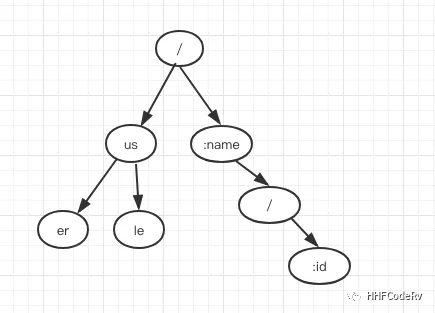gin 原理剖析说到这里,就完全进入 gin 的逻辑里面了。gin 已经拿到 http 请求了,第一件重要的事情肯定就是重写路由了,所以本节内容主要是分析 gin 的路由相关的内容。
其实 gin 的路由也不是完全自己写的,其实很重要的一部分代码是使用的开源的julienschmidt/httprouter,当然 gin 也添加了部分自己独有的功能,如:routergroup。
gin 路由设计
RESTful 是区分方法的,不同的方法代表意义也完全不一样,gin 是如何实现这个的呢?
其实很简单,不同的方法就是一棵路由树,所以当 gin 注册路由的时候,会根据不同的 Method 分别注册不同的路由树。
GET /user/{userID} HTTP/1.1POST /user/{userID} HTTP/1.1PUT /user/{userID} HTTP/1.1DELETE /user/{userID} HTTP/1.1
如这四个请求,分别会注册四颗路由树出来。
func (engine *Engine) addRoute(method, path string, handlers HandlersChain) {//....root := engine.trees.get(method)if root == nil {root = new(node)root.fullPath = "/"engine.trees = append(engine.trees, methodTree{method: method, root: root})}root.addRoute(path, handlers)// ...}
其实代码也很容易看懂,
- 拿到一个 method 方法时,去 trees slice 中遍历
- 如果 trees slice 存在这个 method, 则这个URL对应的 handler 直接添加到找到的路由树上
- 如果没有找到,则重新创建一颗新的方法树出来, 然后将 URL对应的 handler 添加到这个路由 树上
gin 路由的注册过程
func main() {r := gin.Default()r.GET("/ping", func(c *gin.Context) {c.JSON(200, gin.H{"message": "pong",})})r.Run() // listen and serve on 0.0.0.0:8080}
这段简单的代码里,r.Get 就注册了一个路由 /ping 进入 GET tree 中。这是最普通的,也是最常用的注册方式。
不过上面这种写法,一般都是用来测试的,正常情况下我们会将 handler 拿到 Controller 层里面去,注册路由放在专门的 route 管理里面,这里就不再详细拓展,等后面具体说下 gin 的架构分层设计。
//controller/somePost.gofunc SomePostFunc(ctx *gin.Context) {// do somethingcontext.String(http.StatusOK, "some post done")}
// route.gorouter.POST("/somePost", controller.SomePostFunc)
使用 RouteGroup
v1 := router.Group("v1"){v1.POST("login", func(context *gin.Context) {context.String(http.StatusOK, "v1 login")})}
RouteGroup 是非常重要的功能,举个例子:一个完整的 server 服务,url 需要分为鉴权接口和非鉴权接口,就可以使用 RouteGroup 来实现。其实最常用的,还是用来区分接口的版本升级。这些操作, 最终都会在反应到gin的路由树上
gin 路由的具体实现
func main() {r := gin.Default()r.GET("/ping", func(c *gin.Context) {c.JSON(200, gin.H{"message": "pong",})})r.Run() // listen and serve on 0.0.0.0:8080}
还是从这个简单的例子入手。我们只需要弄清楚下面三个问题即可:
- URL->ping 放在哪里了?
- handler-> 放在哪里了?
- URL 和 handler 是如何关联起来的?
1. GET/POST/DELETE/..的最终归宿
func (group *RouterGroup) GET(relativePath string, handlers ...HandlerFunc) IRoutes {return group.handle(http.MethodGet, relativePath, handlers)}
在调用POST, GET, HEAD等路由HTTP相关函数时, 会调用handle函数。handle 是 gin 路由的统一入口。
func (group *RouterGroup) handle(httpMethod, relativePath string, handlers HandlersChain) IRoutes {absolutePath := group.calculateAbsolutePath(relativePath)handlers = group.combineHandlers(handlers)group.engine.addRoute(httpMethod, absolutePath, handlers)return group.returnObj()}
2. 生成路由树
下面考虑一个情况,假设有下面这样的路由,你会怎么设计这棵路由树?
GET /abcGET /abdGET /af
当然最简单最粗暴的就是每个字符串占用一个树的叶子节点,不过这种设计会带来的问题:占用内存会升高,我们看到 abc, abd, af 都是用共同的前缀的,如果能共用前缀的话,是可以省内存空间的。
gin 路由树是一棵前缀树. 我们前面说过 gin 的每种方法(POST, GET …)都有自己的一颗树,当然这个是根据你注册路由来的,并不是一上来把每种方式都注册一遍。gin 每棵路由大概是下面的样子
3. handler 与 URL 关联
type node struct {path stringindices stringwildChild boolnType nodeTypepriority uint32children []*node // child nodes, at most 1 :param style node at the end of the arrayhandlers HandlersChainfullPath string}
node 是路由树的整体结构
- children 就是一颗树的叶子结点。每个路由的去掉前缀后,都被分布在这些 children 数组里
- path 就是当前叶子节点的最长的前缀
- handlers 里面存放的就是当前叶子节点对应的路由的处理函数
当收到客户端请求时,如何找到对应的路由的handler?
net/http 非常重要的函数 ServeHTTP,当 server 收到请求时,必然会走到这个函数里。由于 gin 实现这个 ServeHTTP,所以流量就转入 gin 的逻辑里面。
func (engine *Engine) ServeHTTP(w http.ResponseWriter, req *http.Request) {c := engine.pool.Get().(*Context)c.writermem.reset(w)c.Request = reqc.reset()engine.handleHTTPRequest(c)engine.pool.Put(c)}
所以,当 gin 收到客户端的请求时, 第一件事就是去路由树里面去匹配对应的 URL,找到相关的路由, 拿到相关的处理函数。其实这个过程就是 handleHTTPRequest 要干的事情。
func (engine *Engine) handleHTTPRequest(c *Context) {httpMethod := c.Request.MethodrPath := c.Request.URL.Pathunescape := falseif engine.UseRawPath && len(c.Request.URL.RawPath) > 0 {rPath = c.Request.URL.RawPathunescape = engine.UnescapePathValues}if engine.RemoveExtraSlash {rPath = cleanPath(rPath)}// Find root of the tree for the given HTTP methodt := engine.treesfor i, tl := 0, len(t); i < tl; i++ {if t[i].method != httpMethod {continue}root := t[i].root// Find route in treevalue := root.getValue(rPath, c.params, unescape)if value.params != nil {c.Params = *value.params}if value.handlers != nil {c.handlers = value.handlersc.fullPath = value.fullPathc.Next()c.writermem.WriteHeaderNow()return}if httpMethod != "CONNECT" && rPath != "/" {if value.tsr && engine.RedirectTrailingSlash {redirectTrailingSlash(c)return}if engine.RedirectFixedPath && redirectFixedPath(c, root, engine.RedirectFixedPath) {return}}break}if engine.HandleMethodNotAllowed {for _, tree := range engine.trees {if tree.method == httpMethod {continue}if value := tree.root.getValue(rPath, nil, unescape); value.handlers != nil {c.handlers = engine.allNoMethodserveError(c, http.StatusMethodNotAllowed, default405Body)return}}}c.handlers = engine.allNoRouteserveError(c, http.StatusNotFound, default404Body)}
从代码上看这个过程其实也很简单:
- 遍历所有的路由树,找到对应的方法的那棵树
- 匹配对应的路由
- 找到对应的 handler

